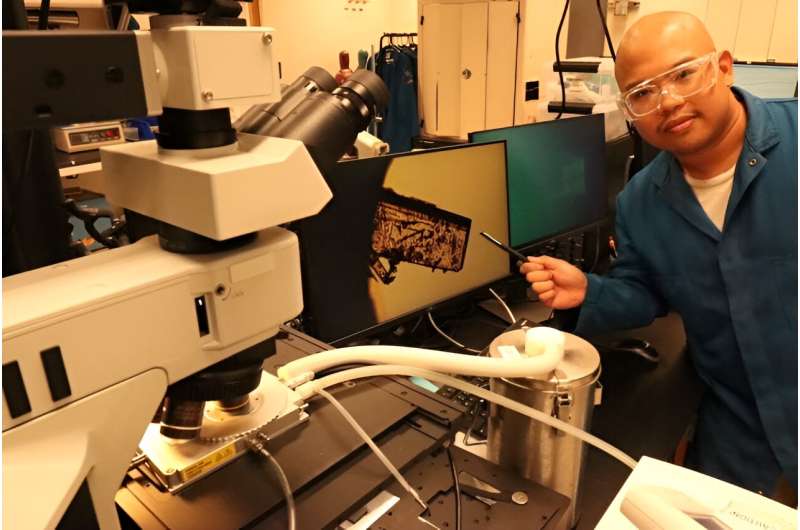This article has been reviewed according to Science X's editorial process and policies. Editors have highlighted the following attributes while ensuring the content's credibility:
fact-checked
peer-reviewed publication
trusted source
proofread
Scientists create material that can take the temperature of nanoscale objects

University of California, Irvine scientists have discovered a one-dimensional nanoscale material whose color changes as temperature changes. The team's results appear in Advanced Materials.
"We found that we can make really small and sensitive thermometers," said Maxx Arguilla, UC Irvine professor of chemistry whose research group led the study. "It's one of the most applied and translatable works to come out of our lab."
Arguilla likened the thermometers to "nano-scale mood rings," referring to the jewelry that changes color depending on the wearer's body temperature. But instead of simply taking a qualitative temperature reading, the changes in the color of these materials "can be calibrated and used to optically take temperature readings at the nanoscale," Arguilla said.
"The need to measure temperature is important because a lot of biological and industrial processes depend on tracking minute changes in temperature," he added. "We may now have thermometers that we could try poking into the cells."
According to Dmitri Cordova, a postdoctoral scholar in Arguilla's group, the optical thermometers can also potentially measure the temperatures and assess the efficiencies of micro- and nano-electronics, including circuits and data storage devices. Industries already have optical thermometers they use when fabricating computer components, but the team's new material is "at least an order of magnitude more sensitive," Cordova said.
The breakthrough happened when Cordova and colleagues grew crystals in their lab, that—at nanometer-length scales—resemble helical "slinkies." They grew the crystals at first so they could subject them to heat stress to see at what temperatures the crystals disintegrate.
Cordova and undergraduate researcher Leo Cheng noticed that the colors of the crystals systematically shifted from yellow to orange, depending on the temperature.
The team then took precise measurements of the temperature range the colors corresponded with, and they found that light yellow colors corresponded to temperatures around -190 degrees Celsius, while red-orange colors corresponded to temperatures around 200 degrees Celsius.
"We spent a lot of effort trying to make sure the measurements were precise," said Arguilla.
To retrieve nanoscale samples of the material, the lab stuck a piece of adhesive tape to bulk-scale crystals, peeled it back and transferred nanoscale samples stuck to the tape onto transparent substrates.
"We can peel off these structures, and we can use them as nanoscale thermometers that can be transferred, reconfigured and coupled with other materials or surfaces," said Arguilla.
Arguilla explained that the discovery is the first step toward discovering new classes of materials to take temperature readings at nanometer scales.
Next, his lab plans to test other nano-scale materials to see if they can develop thermometers that can measure a wider range of temperatures.
"We're now trying to hack the materials design rules to make even more sensitive materials," Arguilla said. "We're trying to open the toolbox for optical thermometry from the bulk scale down to the nanoscale."
Co-authors include Yinong Zhou, Griffin M. Milligan, Leo Cheng, Tyler Kerr, Joseph Ziller, and Ruqian Wu.
More information: Dmitri Leo Mesoza Cordova et al, Sensitive Thermochromic Behavior of InSeI, a Highly Anisotropic and Tubular 1D van der Waals Crystal, Advanced Materials (2024). DOI: 10.1002/adma.202470162
Journal information: Advanced Materials
Provided by University of California, Irvine





















